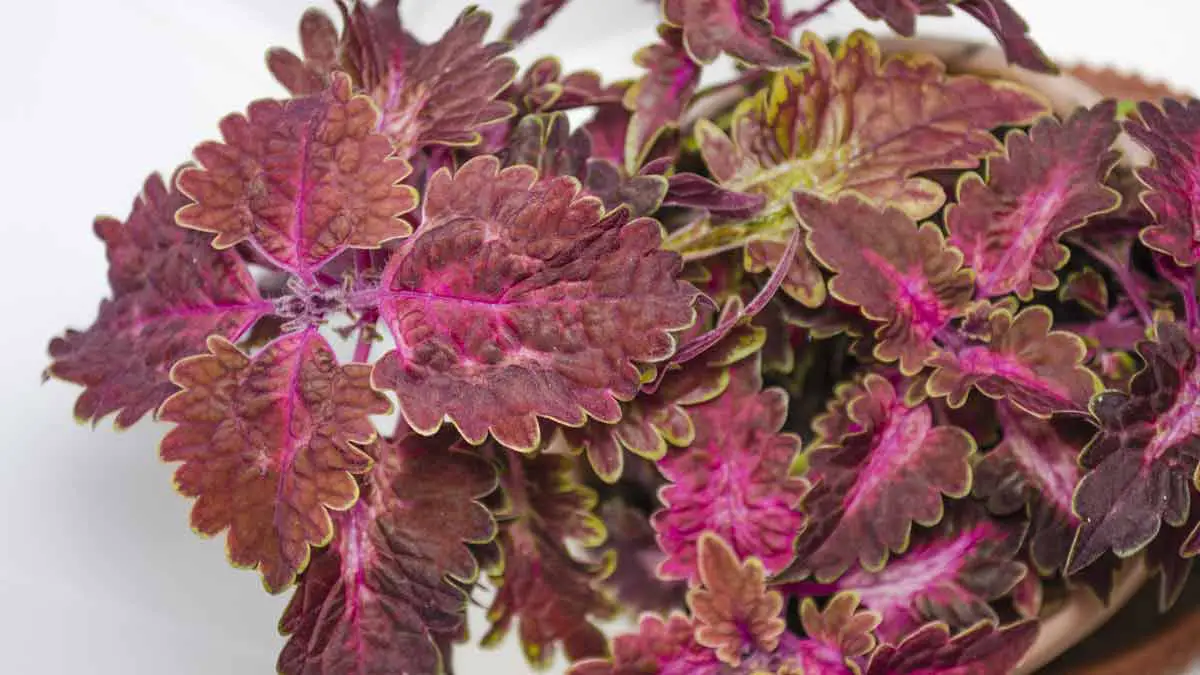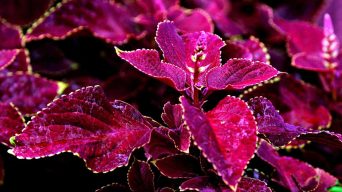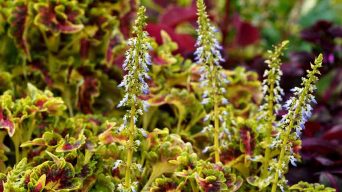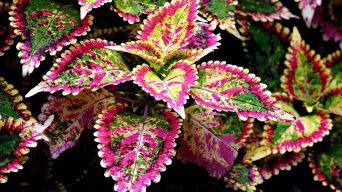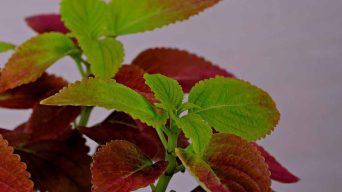Coleus plants are known for their vibrant, colorful leaves that can brighten up any space. These easy-to-care-for plants are a popular choice for both indoor and outdoor gardens.
But what do you do when you notice your Coleus wilting?
There are several reasons why your coleus plant may be wilting.
Keep reading to learn about the most common causes of a wilting coleus plant and what you can do to revive it.
Why Is My Coleus Wilting and What Should I Do About It?
Wilting is a common problem with Coleus plants. If you notice your Coleus plant wilting, a few things could be causing the problem.
The most common reasons for a wilting Coleus plant include:
1. Lack of Water
One of the most common reasons a Coleus plant wilt is lack of water.
Water is essential for plants because it helps them to absorb nutrients from the soil and stay hydrated.
When the Coleus plant doesn’t have enough water, the plant won’t be able to absorb the nutrients it needs to stay healthy, and the leaves will start to wilt.
How To Tell If Your Coleus Plant Is Wilting Due To A Underwatering
A few signs will help you to know if your Coleus plant is wilting due to lack of water.
In addition to wilting, you may also notice:
- The leaves of the Coleus plant turn yellow
- The leaves of the Coleus plant begin to fall off
- The soil around the Coleus plant is dry and cracked
- The Coleus plant is drooping
- The Coleus plant seems stunted or slow-growing
How To Treat A Wilting Coleus Plant Due To Lack Of Water
If you think your Coleus plant is wilting due to lack of water, you first need to water the plant.
Give the Coleus plant a good watering, ensuring that the soil is moistened through.
They must be watered at least once a week but more frequently during hot, dry weather.
Water your Coleus plant in the morning so the leaves have time to dry off before nightfall.
Once you have watered the Coleus plant, you should see an improvement within a day or two.
If the Coleus plant doesn’t improve after being watered, another issue may be causing the problem.
2. Too Much Water
While lack of water is a common cause of wilting, too much water can cause problems.
When the Coleus plant gets too much water, the roots will start to rot. This can happen if the plant is left in standing water or if the soil around the plant is constantly wet.
If the roots of the Coleus plant are rotting, the plant will not be able to absorb the water and nutrients it needs to stay healthy.
The leaves of the Coleus plant will start to wilt and turn yellow. The plant may also begin to produce fewer leaves.
How To Tell If Your Coleus Plant Is Wilting Due To Overwatering
A few signs will help you to know if your Coleus plant is wilting due to overwatering.
You may also notice the following:
- The leaves of the Coleus plant turn yellow
- The leaves of the Coleus plant begin to fall off
- Mushy or smelly roots
- The Coleus plant is drooping
- The Coleus plant seems stunted or slow-growing
How To Treat A Wilting Coleus Plant Due To Overwatering
If you think your Coleus plant is overwatered, you first need to stop watering the plant.
Allow the soil around the Coleus plant to dry out completely before you water the plant again.
Once the soil is dry, water the Coleus plant, making sure that the soil is moistened all the way through.
They must be watered at least once a week but more frequently during hot, dry weather.
You may also need to check the drainage of the pot or container that the Coleus plant is in.
If the pot does not have adequate drainage, the roots of the Coleus plant will start to rot.
3. Low Humidity
Coleus plants are native to tropical climates and prefer high humidity.
They need a humidity level of at least 50% to stay healthy.
If the humidity level drops below 50%, the Coleus plant will wilt.
The leaves of the Coleus plant will turn brown, and the plant may also produce fewer leaves.
How To Tell If Your Coleus Plant Is Wilting Due To Low Humidity
A few signs will help you know if your Coleus plant is wilting due to low humidity.
In addition to wilting, you may also notice:
- The leaves of the Coleus plant are dry and brittle.
- The tips of the leaves are brown.
- The Coleus plant is not producing as many leaves as it used to.
- The Coleus plant is not growing as quickly as it used to.
How To Treat A Wilting Coleus Plant Due To Low Humidity
If you think your Coleus plant is wilting due to low humidity, you first need to increase the humidity around the plant.
One way to do this is to place the Coleus plant on a pebble tray.
Fill a tray with pebbles and water, and then place the Coleus plant on top of the pebbles.
The water will evaporate and increase the humidity around the plant.
You can also mist the Coleus plant with water a few times a day.
4. Too Much Direct Sunlight
Coleus plants need bright, indirect sunlight to stay healthy.
They should be placed in an area where they will get 4-6 hours of sunlight each day.
The leaves will wilt and turn yellow if the Coleus plant gets too much direct sunlight.
The plant may also produce fewer leaves.
How To Tell If Your Coleus Plant Is Wilting Due To Too Much Direct Sunlight
A few signs will help you to know if your Coleus plant is wilting due to too much direct sunlight.
Other signs you may also notice are:
- The leaves of the Coleus plant are dry and brittle.
- The leaves of the Coleus plant are turning yellow.
- The leaves of the Coleus have brown or black spots.
- The Coleus plant is not producing as many leaves as it used to.
How To Treat A Wilting Coleus Plant Due To Too Much Direct Sunlight
If you think your Coleus plant is wilting due to too much direct sunlight, you first need to move the plant to an area where it will get less sunlight.
An east- or west-facing window is a good option. This way, the Coleus plant will get plenty of bright indirect sunlight.
When growing Coleus plants indoors, you can also use grow lights to provide the plant with the light it needs.
Outdoors, you can provide shade by placing the Coleus plant under a tree or patio umbrella.
5. Lack of Light
Coleus plants need bright indirect sunlight to stay healthy.
Light is essential to plants because it helps them to produce food through photosynthesis.
If the plant is not getting enough light, it will start to wilt, and the Coleus leaves will turn green and yellow.
The plant may also produce fewer leaves.
How To Tell If Your Coleus Plant Is Wilting Due To A Lack Of Light
A few signs will help you to know if your Coleus plant is wilting due to a lack of light.
In addition to wilting, you may also notice the following:
- The leaves of the Coleus plant are turning green and yellow.
- The Coleus plant is not growing as quickly as it used to.
- The Coleus plant is not producing as many leaves as it used to.
- The Coleus plant leans towards the light source.
How To Treat A Wilting Coleus Plant Due To A Lack Of Light
If you think your Coleus plant is wilting due to a lack of light, you first need to move the plant to an area where it will get more light.
An east- or west-facing window is a good option. This way, the Coleus plant will get plenty of bright indirect sunlight.
When growing Coleus plants indoors, you can also use grow lights to provide the plant with the light it needs.
Outdoors, you can move the Coleus plant to an area where it will get more light, but ensure it doesn’t get too much direct sunlight, which can harm the plant.
6. Overfertiilzing
Fertilizer is essential for Coleus plants because it provides them with the nutrients they need to stay healthy.
However, if you fertilize the Coleus plant too often or use a fertilizer that is too strong, it can cause the plant to wilt.
The leaves of the Coleus plant may also turn yellow, and the plant may produce fewer leaves.
How To Tell If Your Coleus Plant Is Wilting Due To Overfertilizing
A few signs will help you to know if your Coleus plant is wilting due to overfertilizing.
In addition to wilting, you may also notice the following:
- The leaves of the Coleus plant turn yellow
- The Coleus plant produces fewer leaves
- The Coleus plant is stunted in growth
- The roots of the Coleus plant are burned
How To Treat A Wilting Coleus Plant Due To Overfertilizing
If you think your Coleus plant is wilting due to overfertilizing, you first need to stop fertilizing the plant.
Then, flush the soil with water to remove any excess fertilizer. To do this, water the plant deeply and then allow the water to drain away.
If the Coleus plant is still wilting, you can try repotting it in fresh soil.
Don’t fertilize the plant again until it has recovered from the wilting.
7. Pest Infestation
Coleus plants can be susceptible to pests, such as aphids, mealybugs, and spider mites.
These pests can suck the sap out of the Coleus plant, causing it to wilt.
Aphids are tiny green or black insects that congregate on the undersides of Coleus leaves.
Mealybugs are tiny white insects that produce a waxy substance. They can be found on the stems and leaves of Coleus plants.
Spider mites are tiny red or brown insects that spin webs on the Coleus plant.
How To Tell If Your Coleus Plant Is Wilting Due To A Pest Infestation
A few signs will help you know if your Coleus plant is wilting due to a pest infestation.
You may also notice the following:
- The leaves of the Coleus plant are covered in small insects or webs
- The leaves of the Coleus plant are yellow
- The leaves of the Coleus plant are curled or distorted
- The Coleus plant is covered in a sticky substance
How To Treat A Wilting Coleus Plant Due To A Pest Infestation
If you think your Coleus plant is wilting due to a pest infestation, you first need to inspect the plant for pests.
If you find any pests on the plant, you can try to remove them by hand. Use a cotton swab dipped in rubbing alcohol to kill mealybugs and spider mites.
You can also use a natural insecticide, such as neem oil, to eliminate pests.
Spray the Coleus plant with the insecticide according to the instructions on the label.
8. Diseases
Coleus plants can be susceptible to diseases such as root rot, downy mildew, and powdery mildew.
These diseases can cause the Coleus plant to wilt.
Root rot is a disease that affects the roots of the Coleus plant. The roots will turn brown or black and may fall off the plant.
Downy mildew is a disease that causes the leaves of the Coleus plant to turn yellow. The leaves may also be covered in white powder.
How To Tell If Your Coleus Plant Is Wilting Due To A Disease
A few signs will help you know if your Coleus plant is wilting due to a disease.
In addition to wilting, you may also notice the following signs:
- The leaves of the Coleus plant turn yellow
- The leaves of the Coleus plant turn white
- The leaves of the Coleus plant fall off the plant
- The roots of the Coleus plant turn brown or black
- The soil around the Coleus plant has a foul odor
How To Treat A Wilting Coleus Plant Due To A Disease
If you think that your Coleus plant is wilting due to a disease, the first thing you need to do is remove the affected leaves.
Dispose of the leaves in the trash so the disease doesn’t spread.
Next, use a natural fungicide, such as neem oil, to treat the disease.
Mix the fungicide with water according to the instructions on the label.
Spray the Coleus plant with a fungicide. Be sure to cover all of the leaves.
You will need to spray the plant every few days until the disease is gone.
9. Temperature Stress
Coleus plants can be sensitive to temperature fluctuations. The Coleus plant may wilt if the temperature is too hot or too cold.
Coleus plants need to be grown in an environment with temperatures between 60°F and 80°F.
If the temperature gets too hot, the Coleus plant will stop growing. If the temperature gets too cold, the Coleus plant may die.
How To Tell If Your Coleus Plant Is Wilting Due To Temperature Stress
A few signs will help you know if your Coleus plant is wilting due to temperature stress.
In addition to wilting, you may also notice the following:
- The leaves of the Coleus plant turn brown
- The leaves of the Coleus plant fall off the plant
- The stems of the Coleus plant are weak and brittle
How To Treat A Wilting Coleus Plant Due To Temperature Stress
If you think your Coleus plant is wilting due to temperature stress, you first need to move the plant to a location with more consistent temperatures.
If the temperature is too hot, move the plant to a cooler location. If the temperature is too cold, move the plant to a warmer place.
You can also try to create a more stable environment for the Coleus plant by using a pebble tray or a fan.
Place the Coleus plant on a tray of pebbles and water. The evaporating water will help to create a more stable environment for the plant.
You can also use a fan to create a more stable environment for the Coleus plant. Point the fan towards the plant so that it blows gently.
This will help to circulate the air and keep the temperature more consistent.
How To Prevent a Coleus From Wilting
You can do a few things to help keep your Coleus from wilting.
Here are some tips:
- Make sure to plant your Coleus in well-draining potting soil.
- Water regularly, but do not overwater.
- Provide bright indirect light.
- Keep an eye on the temperature. Coleus wilts more quickly in high temperatures.
- If you live in a hot climate, try growing Coleus in partial shade.
- Fertilize every few weeks during the growing season.
- Pinch back the stems of your Coleus regularly to encourage new growth.
- Prop up any stems that start to droop.
You can keep your Coleus healthy and looking its best with some care. By following these tips, you can prevent your Coleus from wilting.
Final Thoughts
If your Coleus is wilting, it could be for several reasons.
However, by paying close attention to the plant and experimenting with different solutions, you should be able to figure out what’s causing the problem and fix it.
In most cases, giving the plant more water or adjusting its light exposure will do the trick.
With a bit of patience and effort, you should be able to get your Coleus back to its healthy self in no time!

